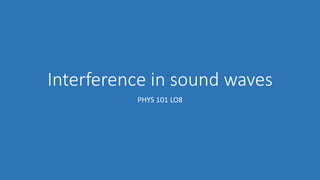
Interference in sound waves
- 1. Interference in sound waves PHYS 101 LO8
- 2. Mummy whale (whale A) and daddy whale (whale B) went for a swim and lost their baby whale (whale C). The two whales decide to call out to their child. All three whales are stationary. Whales A and B are both calling towards whale C with a frequency of 17Hz. The sound waves produced by both whales start at the node (so the sound waves can be represented by the sine curve). The distance between whales B and C is 1090.25m. The speed of sound in ocean water is 1513m/s. (Assume that no damping occurs).
- 4. In this case, what would the distance between whales A and B have to be so that: 1. their calls cancels out as it reaches the baby? 2. their calls combine to be the loudest possible when it reaches the baby whale? There will be multiple possible answers so express your answer in a general algebraic form.
- 5. Answers Q1: 44.5x m (where x is an integer) Q2: 89x m (where x is an integer)
- 6. Explanation for Q1 First we need to determine wavelength using equation λ=v/f λ=1513/17=89m
- 7. Then we can draw the following diagram showing the sound waves of the whales. The blue line represent whale B’s sound waves and the pink lines represents whale A’s sound waves. The resultant wave is represented by the black line. In order for the sounds to cancel (destructive interference), whale A must be half a wavelength apart from whale B, or a multiple of this value. Since half a wavelength is 89/2=44.5m, the distance between A and B needed for destructive interference to occur is 44.5x m (where x is an integer).
- 8. Explanation for Q2 In order for constructive interference to occur when the sound waves reach whale C, the sound waves produced by whales A and B must completely overlap each other. We can find out how far whale B is from whale C in terms of λ : 1090.25/89=12.25 (whale C is 12.25 wavelengths away from whale B)
- 9. It turns out that if whale B’s sound wave starts at a node, then 12.25 wavelengths later, the wave will reach whale C at an antinode. Again in this diagram the blue line represent whale B’s sound waves and the pink lines represents whale A’s sound waves, and the resultant wave is represented by the black line. This means that as long as whale A is one (or a multiple of one) wavelength/s away from whale B, their sound waves will double in amplitude when it reaches whale C, as seen in the diagram. So the distance needed between whales A and B for constructive interference to occur is 89x m (where x is an integer).